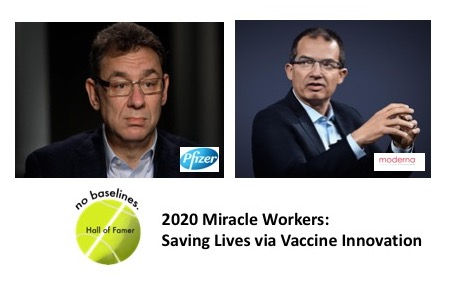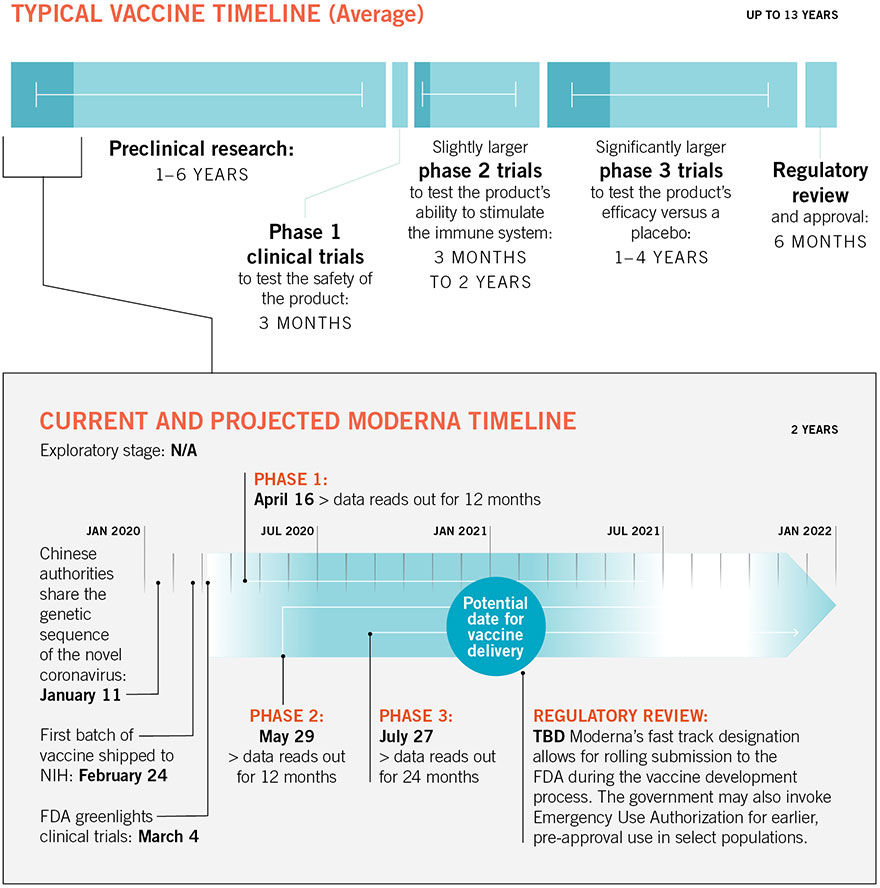
So long, 2020 – it seemed like an eternity, but you are finally gone. Here's hoping 2021 will be an improvement; in fact, it's very hard to imagine that the new year could be worse than the old one.
Our hope for 2021 is depending on the vaccinations developed, tested, approved, and manufactured in warp speed by the Nobaseliners at Moderna and Pfizer/BioNTech. Their out-of-the box thinking with superhuman speed delivered a highly effective treatment (90+%) in a miraculously shorter time than any previous vaccine in history (see comparative below). Their herculean achievement will not only save lives, but help bring us back to a world that feels “normal” again.

.
The Pfizer and Moderna saviors are our 2020 Hall of Famers for their unprecedented response to the world’s dire situation. What can we learn from their incredible and miraculous accomplishment? We curated recent media coverage to highlight thoughtful and inspiring content about our Hall of Famers.
Different Approaches to Meet the Challenge
Stephane Bancel (CEO) is the architect of Moderna’s innovative strategy that made the vaccine: the platform, the technology, and the moves behind the vaccine’s development. In a revealing interview on The Machine that Made the Vaccine podcast (Andreessen Horowitz), Bancel describes the exact moment he realized they might actually be able to make a vaccine for Covid-19; what happened next to go from pathogen to design; how this new technology uses mRNA and what makes it different from “old” vaccines; and how to think about managing both innovation and speed in this world. A totally inspiring discussion.
To better understand the medical approach taken by our Hall of Famers, please review this excerpt from the NYTimes:
“Unlike older, slower ways of developing vaccines, which involve stimulating the body’s immune system by injecting inactivated or weakened viruses, Moderna and Pfizer (inserted) created platforms that work like the operating system on a computer, allowing researchers to quickly insert new genetic code from a virus — like adding an app — and create a new vaccine.
The method employs a synthetic form of a genetic molecule called messenger RNA, or mRNA, to cause human cells to make a harmless viral protein called a spike, which then stimulates the immune system to make antibodies and immune cells that can recognize the spike quickly and counterattack when needed.” The Remarkable Race for a Coronavirus Vaccine (NYTImes (11/22/2020))
To compliment the breakthrough medical approach, an equally bold and innovative business model was necessary. To swiftly move through the phases of development, Moderna’s process was completely revamped and condensed. For comparison, the timeline below contrasts a typical pre-COVID vaccine with that of Moderna’s trajectory, which has been accelerated by unprecedented levels of funding and cooperation ( Harvard Business School-“HBS”- (9/20/2020)).

According to HBS, the vaccine development process pauses between each phase for evaluation and planning. When time is of the essence and money a secondary concern, as with COVID-19 research, those phases overlap, as shown above. Investments are made, for instance, in Phase 2 testing before Phase 1 data is available. If the vaccine candidate proves safe, Phase 2 can start immediately. If it fails the safety test, the money is lost. Likewise, companies are already manufacturing and stockpiling doses of vaccines. If a vaccine proves unsafe or ineffective, all those doses will be destroyed—which seems like a waste, until you consider that beginning production the day a vaccine is approved would add six months or more to distribution efforts.
The incredible speed to market would not have occurred without the Nobaseliners approach to the medical science and business model. Challenging conventional wisdom and applying innovative thinking resulted in a game-changing event for all of humanity.
Creating Miracles: Passion and Deliberation
The 2020 Hall of Famers were the Miracle Workers from Moderna and Pfizer for their incredible contribution to humanity. How were they able to succeed and accomplish this impossible mission at record speed? Pfizer’s CEO Albert Bourla told his research team that they should think, “this is not business as usual.” There is no consideration of return on investments. This is considered to have an open checkbook. He added, “I believe in the power of science. I believe in the power of the private sector. And I believe in the miracles that science in the private sector can do for mankind” ( 60 Minutes (12/20)).
To provide a final perspective, Kathrine Jansen, Head of Vaccine R&D at Pfizer, revealed on that same 60 Minutes broadcast, “We can call it a miracle. But a miracle always has a sense of it just happened. It didn't just happen. Right? It was something that was deliberate. It was with passion, done with passion. It was urgency. It was always having in your sight that devastating disease.”
These are great words to live by.
Referenced Content
The Remarkable Race for a Coronavirus Vaccine (NYTImes (11/22/2020)):
How the Pfizer-BioNTech COVID-19 vaccine was developed (60 Minutes (12/20)).
The Race for a Vaccine ( Harvard Business School-“HBS”- (9/20/2020)).
The Machine that Made the Vaccine (podcast Andreessen Horowitz)
Also, a great explanation on how the Moderna vaccine works (NYTimes12/29/20)

Comments